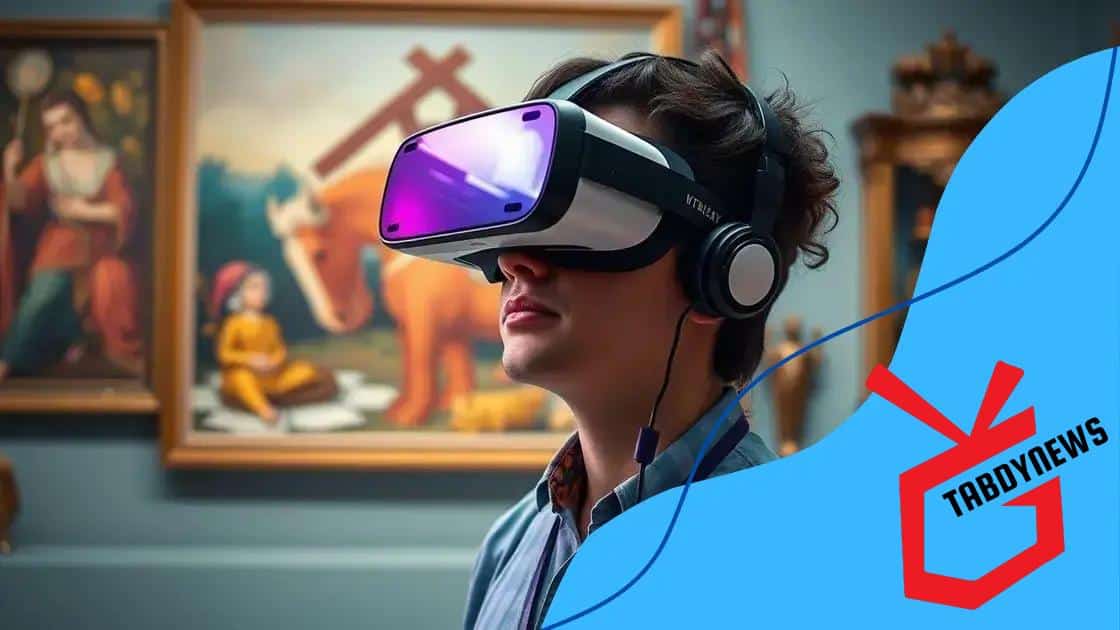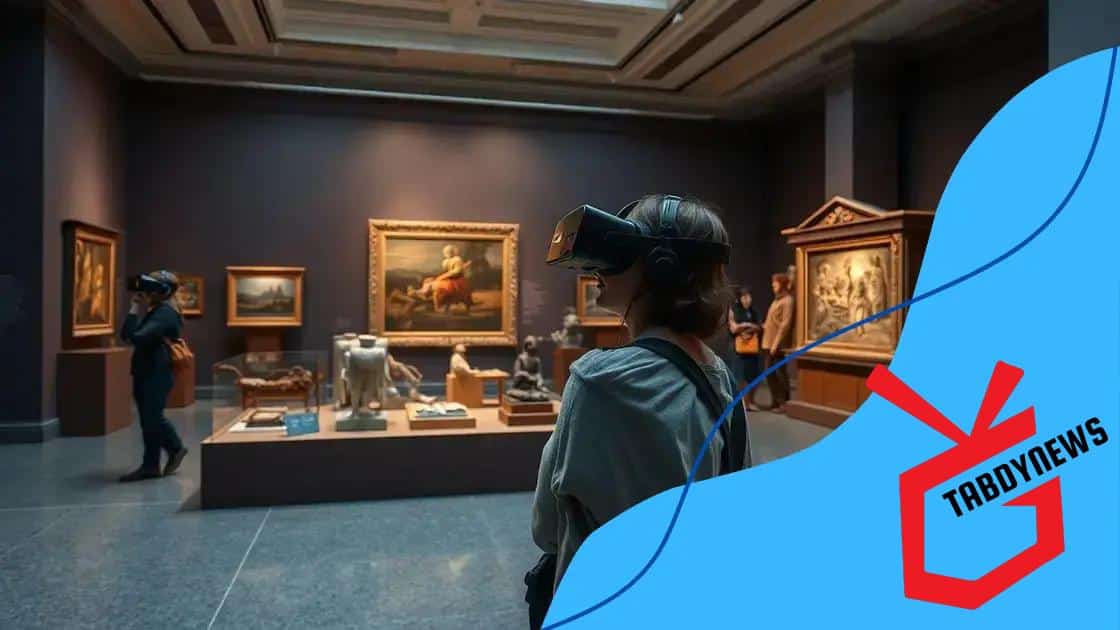Virtual reality enhancing cultural experiences

Virtual reality enhances cultural experiences by providing immersive and interactive ways to engage with art and history, making cultural heritage accessible and helping to preserve historical sites for future generations.
Virtual reality enhancing cultural experiences is transforming how we interact with art and culture. Have you ever wondered how technology can bring history to life? In this article, we’ll delve into how VR is reshaping our cultural landscapes.
Understanding virtual reality in cultural contexts
Understanding virtual reality in cultural contexts opens up new experiences. The way we perceive art and history is changing rapidly thanks to technology. By immersing ourselves in virtual environments, we can visit places we might never reach in real life.
The Evolution of Virtual Reality
Initially, virtual reality was seen as something just for gamers. Now, it’s a powerful tool for cultural institutions. Museums and galleries use VR to transport visitors into different times and places.
Benefits of Virtual Reality in Culture
There are several significant benefits:
- Accessibility: Virtual reality bridges gaps for people with mobility issues.
- Engagement: It creates interactive experiences, making history feel real.
- Education: VR allows for immersive learning experiences that enhance understanding.
Using VR technology, people can walk through ancient ruins or experience significant historical events. Imagine exploring the pyramids of Egypt or walking alongside dinosaurs—all from your living room. This type of engagement fosters a deeper connection to our heritage.
Challenges in Adoption
While the benefits are clear, there are challenges. Not all institutions have the resources to implement this technology. There are also concerns about the quality of the VR experience and the need for proper guidance.
Despite these challenges, the future of virtual reality in cultural contexts looks promising. As technologies improve, more people will have access to these enriching experiences. They can connect with cultures around the world in ways never thought possible.
How VR shapes art experiences
How VR shapes art experiences is something truly fascinating. With the rise of technology, art has entered a new era. Artists and institutions now use virtual reality to create unique experiences for viewers.
Immersive Art Installations
In traditional galleries, you observe art from a distance. However, with virtual reality, you can step into the artwork. This immersion allows viewers to interact with the piece, making art more engaging.
Creating Connection with Artists
Another benefit is the direct connection people feel with artists. Viewing creations in VR can tell stories behind the art that traditional formats may not convey. This emotional connection enhances the viewer experience significantly.
- Storytelling: VR encourages narrative experiences that engage the audience.
- Interactivity: Viewers can touch and manipulate the art, breaking down barriers.
- Accessibility: More people can access art regardless of their physical location.
Some projects invite the audience to influence the art itself, responding to their movements or choices. This dynamic interaction makes art alive, altering how we understand creativity.
Challenges of VR in Art
Despite its benefits, there are challenges. Not all artists have the resources to create VR experiences. Additionally, some struggle with technological limitations that can hinder the final product.
As technology improves, more artists will embrace virtual reality. The goal is to make art accessible and engaging for everyone. This shift also encourages new forms of creation, continually pushing the boundaries of what art can represent.
Benefits of VR in museums and galleries

The benefits of VR in museums and galleries are transforming how we experience culture. By using virtual reality, visitors engage with art and history in thrilling ways, making experiences richer and more accessible.
Enhanced Accessibility
VR technology provides access to those who may not be able to visit museums in person. This is especially important for individuals with mobility challenges or those living in remote areas. Virtual tours allow everyone to explore stunning exhibitions without limitations.
Interactive Learning Opportunities
Traditional exhibits often present information in passive formats. In contrast, VR offers interactive learning. Visitors can dive into the stories behind artworks or artifacts, often participating in their own historical explorations.
- Immersive Experiences: Visitors can experience events from the past, such as ancient civilizations or significant historical moments.
- Gamification: Engaging elements can turn learning into a game, making it fun and educational.
- Multi-Sensory Interaction: Using sound and visuals together enhances understanding and retention.
Through VR, museums can also present collections that might otherwise be too fragile or valuable to display. Instead of just looking at paintings, visitors can walk through virtual galleries and even explore 3D models of historical sites.
Increasing Visitor Engagement
Engagement levels rise when audiences can interact with exhibits actively. This interactivity creates memorable experiences, boosting visitor satisfaction. Studies show that people retain more information when they are part of the learning process.
As museums and galleries embrace virtual reality, they attract new audiences. Younger generations, who are often tech-savvy, appreciate these innovative approaches. By incorporating technology, cultural institutions can remain relevant and continue to inspire.
The role of VR in preserving cultural heritage
The role of VR in preserving cultural heritage is vital in today’s world. As our global society evolves, many historical sites and traditions face threats from climate change, war, and urban development. Virtual reality emerges as a powerful tool to safeguard these precious resources.
Documenting Historical Sites
One major benefit of using VR is the ability to document and recreate historical sites. This technology captures detailed images and data from locations that may be at risk. Preservationists can create virtual replicas of these spaces, making them accessible to future generations.
Reviving Traditions
In addition to architectural preservation, VR helps in reviving and showcasing cultural practices. For example, traditional dances, rituals, or crafts can be recorded and shared through virtual experiences. Audiences can witness and learn these traditions, promoting cultural appreciation.
- Global Accessibility: People from around the world can experience cultures they may never visit.
- Educational Opportunities: Schools can incorporate VR to teach students about diverse cultures in an interactive way.
- Community Engagement: Local communities can participate in the creation of their VR cultural stories.
Moreover, VR allows curators to create exhibitions that tell comprehensive stories about cultural artifacts. Instead of just seeing an object, visitors can experience its history, enhancing their understanding and connection.
Challenges in Implementation
While virtual reality offers great potential, there are challenges. High costs and the need for technical expertise can hinder some organizations. Additionally, not all cultures may want their heritage represented in a digital format.
Despite these hurdles, creating virtual reality experiences encourages discussions on how we can honor and preserve our shared heritage for years to come. As more institutions recognize the possibilities, we can expect even more innovative solutions to emerge.
Future trends in virtual reality and culture
Future trends in virtual reality and culture are exciting and filled with potential. As technology advances, we expect new applications that will further enrich cultural experiences. VR is not just a trend but a way to reshape how we connect with art, history, and each other.
Integration with Artificial Intelligence
One major trend is the integration of artificial intelligence with VR. This combination can create personalized cultural experiences. Imagine a VR tour that adjusts content based on your interests. AI algorithms might analyze visitor behavior to improve engagements and tailor experiences, making art and history more relevant to each individual.
Collaborative Virtual Experiences
Another trend is collaborative VR experiences. People from different parts of the world can share experiences in real-time. This connectivity allows for shared learning moments and cultural exchanges without geographical barriers.
- Global Workshops: Artists from different cultures can collaborate and create, showcasing diversity.
- Live Events: Audiences can attend live performances or exhibitions virtually, enhancing accessibility.
- Social Interaction: Visitors can meet and interact with others, forming connections that wouldn’t happen otherwise.
Moreover, as VR hardware becomes more affordable, more institutions and creatives will adopt it. This democratization of technology means that innovative cultural projects can emerge from unexpected places. Small museums and individual artists could share their work with a global audience.
Preserving Cultural Heritage
The preservation of cultural heritage will also evolve with VR. We might see even more intricate recreations of historical sites, allowing for immersive educational opportunities. Future technologies could enable us to explore ancient civilizations as if we were there.
In summary, the future of virtual reality and culture is bright and full of opportunities. As these technologies develop, they will continue to challenge our understanding and experiences of art and heritage.
The future of virtual reality in culture is promising and filled with exciting possibilities. As technology advances, we can expect more innovative ways to experience art, history, and heritage. Virtual reality offers unique opportunities for preserving cultural heritage while fostering global connections. By embracing these changes, institutions and individuals can work together to create engaging experiences that appeal to diverse audiences. As we look ahead, the potential for VR to enrich our understanding of culture is vast and inspiring.
FAQ – Frequently Asked Questions about Virtual Reality and Culture
How does VR enhance cultural experiences?
VR makes cultural experiences more interactive and immersive, allowing users to engage with art and history in exciting new ways.
What are the benefits of using VR in museums?
VR increases accessibility, allows for interactive learning, and helps preserve cultural heritage, making it easier for visitors to experience and appreciate exhibits.
Can VR help preserve historical sites?
Yes, VR can document and recreate historical sites, allowing future generations to explore and learn about them, even if they cannot visit in person.
How can AI be integrated with VR?
AI can tailor VR experiences to individual preferences, creating personalized cultural experiences based on user engagement and interaction.


